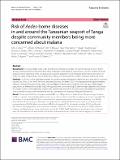| dc.description.abstract | Background Increased global trade, while beneficial economically, can also increase the spread of vector-borne
diseases, particularly those transmitted by Aedes mosquitoes spreading via trade routes. Given the heightened trade-
induced activity at ports of entry, it is particularly crucial to assess the risk of mosquito-borne diseases in these set-
tings. This study compared the risks of Aedes-borne disease in and around the eastern Tanzanian seaport of Tanga.
Methods A 200 m × 200 m grid-based system was used to sample mosquitoes within the port area, and in surround-
ing areas at 2 km, 2.5 km, and 5 km away, between June and December 2023. We characterized mosquito breeding
habitats, collected mosquito larvae using standard dippers and tested susceptibility of raised adult Aedes aegypti
populations to different insecticides. Adult mosquitoes were collected using BG sentinel traps (daytime) and Centers
for Disease Control (CDC) light traps (night-time). Additionally, more than 200 port users and neighboring residents
were surveyed to assess their experiences with and perceptions of mosquito biting and disease risks.
Results There were 2931 breeding sites, with (60.8%, n = 1782) positive for Aedes larvae. The percentage of water-
holding containers infested with Aedes immatures, i.e., the container index (CI), was highest in the port area (66.2%),
and lowest 5 km away (44.6%). The port area also had a greater proportion of temporary breeding sites (64.9%)
than did the surrounding areas. The adult mosquito surveys revealed 20,449 mosquito species including: Culex
quinquefasciatus (56.2%), Mansonia uniformis (38.6%), Ae. aegypti (5.1%), Anopheles gambiae (0.1%), and Anoph-
eles funestus. Ae. aegypti were more abundant in the port area than in the surrounding areas (P < 0.001), whereas
Culex sp., and Mansonia sp., were significantly outside (P < 0.001). Adult Anopheles sp., were found only in the port
area, but Anopheles larvae were found both within and outside the port areas. Tests on Ae. aegypti sp., revealed
susceptibility to bendiocarb and DDT, and resistance to permethrin. Awareness of mosquito-borne diseases
among respondents was high for malaria (64.8%), but low for dengue (26.3%) and Chikungunya (1.7%). Most respond-
ents reported being bothered by mosquitoes mostly at night (53.4%) or in the evening (40.7%). In addition to insecti-
cidal bednets, which are used primarily against malaria, preventive measures for Aedes-borne diseases are limited.
Conclusions This study identified significant potential risk of Aedes species, specifically Ae. aegypti sp., and associated
diseases, but low perception of risk and inadequate personal protection measures in the study area. This low percep-
tion of risk highlights the need to improve public knowledge of the transmission and control of Aedes-borne diseases. | en_US |

